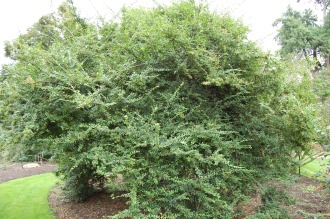Position: Full sun and partial shade
Flowering period: Summer
Soil: Well drained soil
Eventual Height: 3m
Eventual Spread: 3m
Hardiness: 7a, 7b, 8a, 8b, 9a, 9b, 10a
Family: Oleaceae
Ligustrum delavayanum is an evergreen shrub with a bushy habit. Its glossy dark green leaves are ovate with entire margins, up to 4cm long and 2cm broad. Its white flowers are small and tubular and appear as short terminal panicles. These are followed by small green berries which mature to blue/ black.
Ligustrum delavayanum, commonly known as the Delavay Privet, is native to south central China. In its native habitat it grows in thickets or woodlands.
The etymological root of the binomial name Ligustrum was an old name for the Privet plant. Delavayanum is named after Pere Jean Marie Delavay (1834–1895), a French missionary and collector of plants in China.
The landscape architect may find Ligustrum delavayanum useful as an evergreen hedge. It may be pruned to produce a formal or flowering informal form. Care should be taken in locating this plant as its fruit is mildly toxic to humans when ingested.
Ecologically, Ligustrum delavayanum flowers are attractive to many species of pollinating insects. It fruit are attractive to some species of birds.
Ligustrum delavayanum prefers moist, fertile, well-drained soils. It tolerates most pH of soil.
If maintaining Ligustrum delavayanum as a hedge, formal or informal, it plant should be trimmed after flowering.







Leave a comment